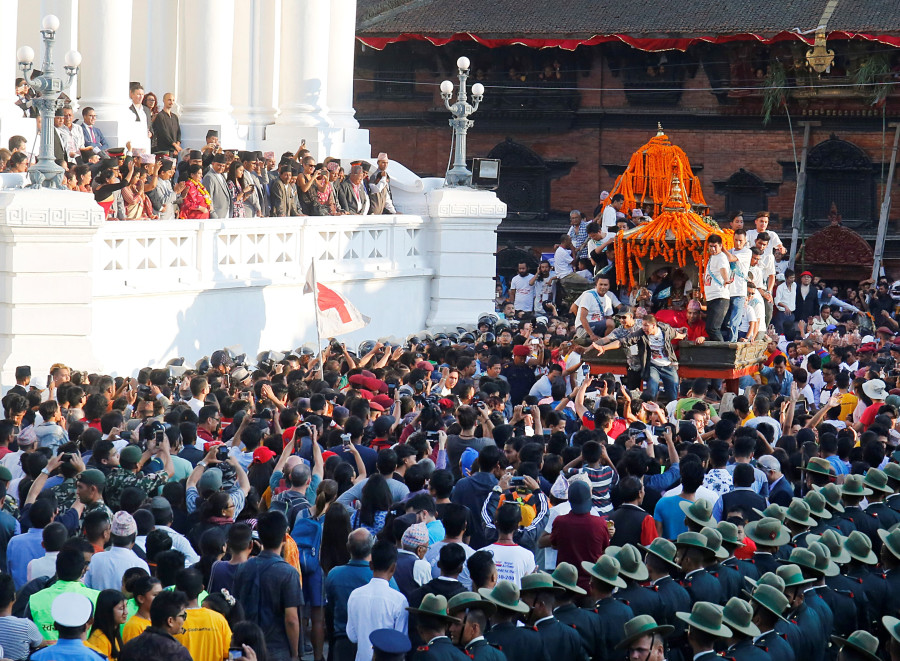Columns
Taking Indra Jatra to the world
The globalisation of the festival is natural since many Newars commemorate it worldwide.
Sanyukta Shrestha
Last Wednesday, the office of the Kathmandu Metropolitan City (KMC) made a welcome announcement of a campaign to internationalise the Indra Jatra festival, with invitations sent to 18 of its sister cities worldwide. The metropolitan city is internationalising the festival in economic terms. But in terms of heritage, and as a consequence of internationalisation, it would eventually lead to the globalisation of the festival. The verdict for the globalisation of cultural heritage cannot be universal but on a case-by-case basis; whether it is right or wrong depends on how it is carried out. It is of utmost importance for cultural globalisation to maintain a required level of negotiation with local traditions, indigenous knowledge and natural landscape. When it comes to intangible heritages like the Indra Jatra, it is equally important to consider the cultural landscape constituted by people's memories, the dynamicity of the built architecture, and the local heritage management practices.
In the history of Hindu festivities, erecting a flagstaff dedicated to Lord Indra is a popular practice, documented in epics like the Ramayan and the Mahabharat. It is still carried out by several indigenous communities and cultural hubs in South Asia, like those in India and Tibet. However, Nepal commemorates it with an unmatched spectacle, the backdrop of Kathmandu’s mediaeval royal architecture adding to its grandeur and authenticity. Nepal is often proudly portrayed as the country where Hindu and Buddhist faiths have historically co-existed. This remarkable social fabric is prominent in the Kathmandu Valley, where this aspect of dual religion is deeply rooted in most of its customs, rituals and festivals.
While some western researchers like Michael Baltutis from the University of Wisconsin have projected Indra Jatra mostly as a Hindu festival, the fact remains that one of the core entities of the festival—the living Goddess Kumari—is traditionally selected from a Buddhist Shakya family affiliated to a selected list of bihars. Furthermore, the primary worship is also conducted by a Vajrayana priest to date. Regarded as the biggest festival of Kathmandu and locally known as YenYaa, it runs for eight days with dance performances of various Buddhist tantric deities.
One of the known challenges of Asian heritage management is the complexity offered by multiple faiths practised by their local communities. They come with well-defined worldviews that mostly do not comply with the Western principles of archaeology and monument-based heritage conservation. The Newar sensibility of heritage is no exception, as it focuses mainly on spiritual rather than material aspects. In the last decade, Neel Kamal Chapagain from Ahmedabad University argued that the Buddhist notion of impermanence, among others, guides the indigenous practice of heritage management in Nepal. Through historical accounts of the evolution of Indra Jatra, renowned French ethnologist Gerard Toffin also noted as early as 1992 that this tenth-century festival from the Lichhavi period got integrated with newer segments like Kumari Jatra and Shvet Bhairav only during the Malla and Shah periods, respectively.
Whether showcasing Indra Jatra as a tourism package will add the risks of freezing the managerial and creative flexibilities of the local communities is a question worth considering. A good plan for globalising ancient cultures like that of Indra Jatra should be free from the risks of museumification and commodification of living cultures. According to the Jatra management team, the audience is proportionately growing with the increasing population of the city. While it is essential to document the local management practices and their challenges, some research on easy scalability and even modelling a crowd simulation can be helpful as a preparation for the anticipated tourism gain.
Besides concerns related to rapid economic progress, Getty Conservation Institute emphasised recognising the living nature of Asian heritage in 1995. Later, in 2003, Article 1 of the UNESCO Convention defined intangible cultural heritage also as "practices" and "representations" that "provide the communities with a sense of identity and continuity". Many facets of the Indra Jatra, including the practice of enshrining a living Goddess Kumari, have great potential to be listed as the next UNESCO-recognised intangible cultural heritage, eventually strengthening the globalisation agenda. Globalisation is a straightforward means for the economic sustainability of Nepal's heritage management, but there are ample instances of such projects going counterproductive to the core agenda of conservation.
Although UNESCO has started recognising the nuances of Asian heritage management in the last two decades, countries like Thailand and Japan were the world leaders in formulating their heritage governing policies leading to the Thai Charter and Nara Document of Authenticity, respectively, which preceded the response to intangible cultures from the West. Nepal is rich in indigenous knowledge and community festivals, but it has failed to recognise its heritage management traditions, which in turn has the potential to influence the modern heritage discourse. Inadequate documentation and failure to build a robust research community have been a letdown. Nepal should overcome this lacklustre stage with an aim for simultaneous particularisation and universalisation, as did Japan with dochakuka in the late 1980s, later theorised in 1992 as glocalisation by the late Roland Robertson from Aberdeen University.
An essential aspect of Indra Jatra is its strong affiliation with state power. Even after the abolishment of the monarchy, presidents of the Republic of Nepal have maintained their official visits to the festival. While republican principles contest this patronage, there is relatively lesser political clarity among the majority of the Nepalese population taking pride in State sanctioning. This is also comparable to how Denis Byrne from Western Sydney University noted in 2014 that the Taiwanese people consider the state recognition of some Mazu temples as an acknowledgement of the goddess's divine status and power. It proves the popularity of this pattern among the believers of what he terms a popular religion. Given that this social pattern is a potential attraction for globalisation prospects, it is likely to continue even without any direct political appropriation. Sikkim, where Indra Jatra was first observed outside Nepal in 2000, welcomed its governor, Ganga Prasad Chaurasia, as the year's chief guest.
Besides KMC's noble attempt this year, the globalisation of Indra Jatra is a natural phenomenon since many Newar communities commemorate it globally. While the earliest commemoration beyond South Asia occurred in the USA in 2011, Canada, Australia and the UK are some other countries where it has been observed. It can be interesting to project a global map of Indra Jatra that locates active regions, documents adaptations and celebrates globalisation.




 15.12°C Kathmandu
15.12°C Kathmandu















